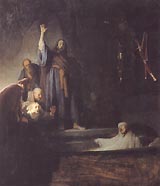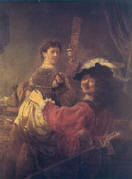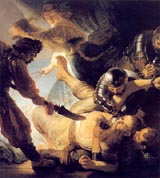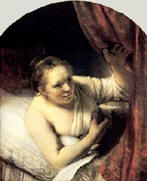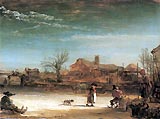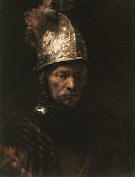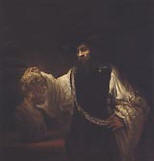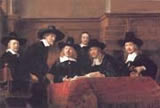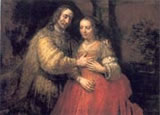
recommended book

the comprehensive Rembrandt book with a wealth of excellent images
by Gary Schwartz
2006


DVD
The Art of Rembrandt
from:
The Dutch Painters: 100 Seventeenth Century Masters
by Christopher Wright, London, 1978, pp. 170
Rembrandt is now thought to be the greatest Dutch painter and also one of the greatest painters of all time. His pre-eminent position is, however, a relatively recent one; eighteenth and nineteenth-century connoisseurs and critics preferred Gerrit Dou and Nicolaes Berchem. The artist's life was relatively uneventful and the all-too-few known facts do little to explain the development of his genius. Born the son of a Leiden mill owner, the young Rembrandt attended the local university in 1620 but in the following year was apprenticed to the now-obscure but then relatively important local artist Jacob Isaacsz. van Swanenburgh (c. 1571-1639?), with whom he remained for three years. In 1624 Rembrandt moved to Amsterdam, where he was apprenticed to the much more fashionable Pieter Lastman, but he only remained there for a year and then returned to Leiden.
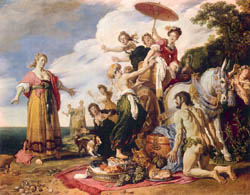
Odysseus and
Nausicaa
Pieter Lastman
panel, 90 x 115 cm.
Alte Pinakothek, Munich
It was not until 1631 that Rembrandt was to receive his first important commission, for the Anatomy Lesson of Dr Tulp (see right b.) which is in the Mauritshuis, The Hague. While the picture is obviously a great step forward for Rembrandt, who had mostly concentrated on small panel pictures of religious and mythological subject matter until this time, the painting of anatomy lessons 'was a matter of course at the period. More usually, however, the doctor concerned is shown explaining the different parts of the skeleton. It is quite astonishing how the artist, from the moment that he"made the final and decisive move to Amsterdam in 1632, was to be so successful as a society portraitist and a painter of official commissions. His formal portraits of these years are numerous, good examples being the pair of father and son and mother and daughter in the Wallace Collection, London. Rembrandt's most fruitful relationship was with Constantin Huyghens, who was the secretary to the Stadholder Prince Frederick Henry of Orange. Jan Lievens painted Huyghens's portrait which is at present on loan to the Rijksmuseum, Amsterdam, and it was through Huyghens that Rembrandt received the commission to paint a Passion series of at least five pictures which were to occupy him at intervals during the 1630s. He was also sufficiently esteemed by the Orange household to receive a commission to paint Amelia von Solms, the Stadholder's wife. This picture has in fact been identified recently; it was formerly thought to represent Rembrandt's sister or his wife Saskia.
Rembrandt married Saskia van Uylenborgh in 1634. She was the daughter of a wealthy burgomaster from Leeuwarden in Friesland, and until her untimely death in 1642 she served as a model for a large number of his religious and mythological pictures. She appeared in the guise of Artemisia (see right c.) (Madrid, Prado) and Rembrandt also painted several single portraits of her, as well as the memorable double portrait of The Artist with Saskia on his Knee (see right d.) (Dresden, Gemaldegalerie).
The 1630s was a period of conspicuous success for the artist and his pictures rarely contain that quality of insight into the human condition of misfortune and sadness which characterizes his later work. Already Rembrandt was a passionate observer of human nature, but he had not yet acquired the skill to take it further. He concentrated on the dramatic, but with a surprising range. The small Flight into Egypt in the Musée des Beaux-Arts at Tours has all the feeling of urgency necessary, but what a contrast this is to the enormous Blinding of Samson (see right e.) at Frankfurt. In spite of their brutality there is an optimistic and self-assured feeling in almost all the pictures in this period. Only occasionally in the self-portraits, which he did throughout his life, is there a sense of introspection and melancholy which was to strengthen in his maturity and dominate his late years.
Rembrandt's most important painting was the Night Watch (see right f.) of 1642. It is now difficult to imagine with hindsight what an impact it must have had on the unsuspecting Amsterdam public. The sitters complained that they had not been given equal prominence. Quite obviously Rembrandt had no intention of painting them in a neat line. But in attempting to produce a feeling.'of movement in a type of picture which was usually, of necessity, static, he created a picture very close in spirit to the Italian Renaissance. He succeeded in integrating a large number of figures so that they appeared natural and at the same time gave the composition a sense of balance and order exactly as Titian, whom he much admired, would have done.
The death of Saskia in 1642 deprived Rembrandt of his chief model and his domestic security. But she left him a small income of the condition that he did not remarry. Not surprisingly, following the public failure of the Night Watch, the 1640s see a decrease in the artist's activity--there are no large compositions as ambitious as the Anatomy Lesson, the. Blinding of Samson or the Night Watch. Instead his paintings become broader in handling and more intimate in feeling and scale. A perfect example of this is the so-called Hendrickje Stoffels in Bed (see right g.) in the Edinburgh Gallery, where the artist has concentrated on the mood of a woman who has just woken from a deep sleep.
It was in the 1640s that Rembrandt took a great interest in landscape. Occasionally they are given a narrative subject, as in the Rest on the Flight in Dublin; at other times they are simply concerned with light and atmosphere as in the surprising little Winter Scene (see right h.) at Kassel. In turning to the highly specialized genre of landscape Rembrandt did not rely on the traditions and conventions of the local specialists. He seemed to ignore the art of his contemporaries but relied heavily on the art of the past. He drew a copy of Leonardo's Last Supper, presumably from an engraving or a painted copy; he copied Persian miniatures and he made sketches of Raphael's Baldassare Castiglione (Paris, Louvre) and of Titian's so-called Ariosto (London, National Gallery) when it passed through an Amsterdam saleroom. Thus Rembrandt's source material is as complex as it is elusive. The finding of a particular source or precedent for one of his pictures does not produce a simple explanation far the picture's inspiration. The Dublin Rest on the Flight is unthinkable without the EIsheimer (Munich, Alte Pinakothek) which inspired it, but Rembrandt has transformed the German's clarity into a mysterious and atmospheric landscape.
The last 20 years of Rembrandt's lire' see him becoming increasingly independent and detached from his artistic environment. His pictures become far more inwardly emotional. The Berlin Man in a Golden Helmet (see right i.) is both a still life of an ageing man in an extravagant gold helmet and a statement about the contrast between the untarnishable gold and the fragile human underneath it.
A surprising number of the paintings from these years are of uncertain date. The artist was beginning to suffer from the [mancial troubles, perhaps caused by extravagance and carelessness, which eventually resulted in his bankruptcy in 1656. It was about this time that the artist had his most important commission from abroad. This came from Don Ruffo, a Sicilian merchant resident in Messina. The commission was for the Aristotle Contemplating the Bust of Homer (see right j.) which is in the Metropolitan Museum, New York. Don Ruffo was so pleased with the picture that he ordered a pendant for it from Guercino, remarking to the Italian artist that he had better paint it in his earlier darker manner, in order that it should not clash with his Rembrandt. Don Ruffo then commissioned Rembrandt to paint an Alexander, and this is almost certainly the picture in Glasgow.
It is this group of pictures--the two for Don Ruffo and the Polish Rider (see right k.) in the Frick Collection, New York--which sum up Rembrandt's career. They all have his near-miraculous brushwork, an ambiguity of subject matter which makes the spectator want to enquire further without ever having the possibility of an easy or explicit solution. We are never sure quite what the Polish Rider is doing.
Until his very last years, which fall into a different category, Rembrandt exerted a profound influence on certain of his contemporaries. This was not general: Aelbert Cyup did not modify his landscapes in the light of Rembrandt's experiments. But it was through the medium of the master-pupil relationship that Rembrandt was able to train a large number of artists to paint in his manner. The less good pupils never recovered, but some of them, like Carel Fabritius, became very good painters in their own right. Rembrandt in fact taught artists as different from one another as Dou, Nicolaes Maes, Gerbrand Eeckhout, and Samuel van Hoostraten. Not surprisingly this has led to many problems of authenticity in evaluating Rembrandt's own work. What is convenient to believe, although it need not be the entire truth, is that Rembrandt often corrected his pupil's work, or occasionally collaborated, as with Dou (an example is in the National Gallery, London). But he seems not to have permitted his pupils to interfere with his own compositions, however large. Thus when he carne to paint the most important commission bf his ' last years, the Conspiracy of Claudius Civilis (see right l.), it was entirely from his own hand.
The contract was first given to one of Rembrandt's own pupils, Govaert Flinck, but he died immediately and Rembrandt himself was asked to paint this colossal picture which was to decorate the whole end wall of the main chamber of the new Town Hall of Amsterdam. In the eyes of his contemporaries it must have been one of the most prestigious commissions of the century. The result was a failure, for reasons which are not exactly clear. The painting was taken down at the artist's own request and never replaced. A fragment of it survives in Stockholm.
Rembrandt's last years must not be seen simply as those of a misanthropic and misunderstood genius struggling and ultimately failing. He was not without commissions in the 1660s, for example the Syndics (see right m.) of 1661-2. But he probably did not have enough official work to make a proper living. Undoubtedly his last years were clouded with domestic failure, and this contributed to the nineteenth-century myth of a romantic and bohemian figure. This makes people see the last self-portraits, not far what they are, as careful pieces of self-observation and analysis, but as symbols of romantic failure.
Rembrandt lived his whole artistic life full of passion and curiosity. He was insatiable for new visual experiences. This is what sets him apart from his contemporaries. Even Frans Hals and Vermeer spent their lives trying to perfect their chosen paths. Rembrandt seems never to have been interested in perfection; there is almost the feeling that he was constantly dissatisfied with his work and tried to find a different solution each time. He loved glitter. His work is full of gold objects, fur, embroidery, fancy helmets, elaborate costumes. His house was full of such objects at the time of the bankruptcy in 1656. On the other hand it is not often realized that a surprisingly high proportion of his surviving output is of conventional portraiture painted to order. There are a relatively larger number of them in the early part of his career, although they occur right until the end in diminished quantities.
Perhaps one of the secrets of Rembrandt's subsequent reputation is his variety. Collectors responded to his art relatively early on. The galleries of Brunswick, Cassel and Düsseldorf (now in Munich) were formed in the early years of the eighteenth century. Quite often, collectors preferred the artist's earlier pictures. Later in the eighteenth century Sir Joshua Reynolds made a collection of Rembrandt's pictures in which those of the middle period predominated and which included the Glasgow Alexander (see right n.). In the nineteenth century his late pictures became popular; the Jewish Bride (see right o.) was discovered and became better known than much of the rest of his work. But it has been left to the twentieth century to produce a more balanced assessment of his genius. Blind admiration has gone too far. Rembrandt has been credited by Romantics with painting the spirit of man, which is not the secret of his greatness. Rembrandt observed the world around him more clearly and with greater insight than any of his contemporaries. In the words of the late nineteenth-century French critic Emile Michel, 'Rembrandt, in effect, belongs to the race of artists who cannot have descendants, the race of Michelangelo, the race of Shakespeare, of Beethoven; like these Prometheuses of art he wanted to ravish the celesti al fife, to put the vibrations of life into still form, to express in the visible, that which by its very nature is non-material and undefineable'.
rembrandt bookshop / museums with rembrandt paintings / the complete vermeer website / rembrandt links
copyright@2018 contact
